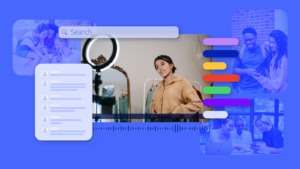Transcription might seem like a straightforward task, but it is an entire industry on its on, with 4 main types of transcription styles. From easing your business operations, producing subtitles for your video content, to transcribing interviews for research firms, lawyers, medical service providers, different needs will require different types of transcriptions.
We break down the 4 types of transcriptions that you will need to know before you start any transcription work.
What are transcriptions?
Audio Transcription
Audio transcription is the process of converting audio content such as speech or a conversation, into text. These transcriptions are used for a multitude of purposes, such as to provide a written record of a meeting or to make the audio content more accessible to people who are deaf or hard of hearing.
Video Transcription
Similar to audio transcription, video transcription converts the audio content from a video file. These transcriptions provide a written or electronic record of the audio content in a video, to make the video content more accessible to people who are deaf or hard or hearing, or to allow the content to be searched and indexed more easily. These transcriptions are also used to create subtitles for the video.
Written Material Transcription
Written material transcription is the process of converting written material, such as notes, printed documents and articles into electronic text. This can be done by a human or with optical character recognition softwares. The resulting transcription can then be used to make the written material more easily searchable or editable.
4 Types of Transcriptions You Need to Know
Here are some of the transcription styles your transcription work might require:
Verbatim transcription
Also referred to as strict verbatim or true verbatim, this transcription style captures every word as spoken, including filler words, laughter, pauses, stutters, and any identifiable background noise.
Example:
Whew. (Applause.) Thank you. (Applause.) This is, this is, sort of a, this is not going to be a short speech. (Laughs.) Erm, so just, c-c-can someone hold this for me? (Laughs.) Because I don’t want this to slip and break, because it is very important to me. (Laughs.) Thank you. Thank you. Yes. Thank you. So, good evening, I want to first thank, er, everyone, all of you, sitting here, from the bottom of my heart, for this honor. I, er, four years ago I couldn’t even imagine myself attending this event. Now I’m here winning an award. I don’t know about y’all, b-b-but, th-th-that’s just crazy to me. (Laughs.)
Verbatim transcription is typically used for translations and recorded legal proceedings.
Edited transcriptions
Also called clean verbatim transcription, this style of transcription removes all unnecessary words in the dialogue or speech. It removes filler words, stammering, and unnecessary non-verbal communication. It is suitable for official documents and is often the default option for transcriptionists.
Example:
Whew. Thank you. This is not going to be a short speech. So just, can someone hold this for me? Because I don’t want this to slip and break, because it is very important to me. Thank you. Thank you. Yes. Thank you. So, good evening, I want to first thank, er, everyone, all of you, sitting here, from the bottom of my heart, for this honor. Four years ago I couldn’t even imagine myself attending this event. Now I’m here winning an award. I don’t know about y’all, but that’s just crazy to me.
Non-verbatim or intelligent verbatim transcription
Unlike verbatim transcription and edited transcription, non-verbatim transcription goes one step further by editing the speech into concise, readable texts, so that it conveys the meaning of the speech in the most natural manner. Transcriptionists will have more leeway to remove repeated words and phrases, and restructure sentences to convey what was meant to be communicated. In this case, they do not have to follow strictly what was communicated.
Example:
Whew. Thank you. This is not going to be a short speech. So can someone hold this for me? I don’t want this to slip and break because it is very important to me. Thank you. Good evening, I want to first thank everyone from the bottom of my heart, for this honor. Four years ago I couldn’t even imagine myself attending this event. Now I’m here winning an award and that’s just crazy to me.
Phonetic transcription
Phonetic transcription is a special transcription style that focuses on dialects and pronunciation, noting the way spoken words are pronounced using phonetic symbols. Same words can be pronounced differently in different countries and regions. Therefore, phonetic transcription requires the transcriber to emphasize word pronunciation depending on the audience. The International Phonetic Alphabet, also called the IPA, is an international alphabet used by linguists to accurately represent the wide variety of sounds in human speech.
If you’re a freelance transcriber, always check with your client about the transcription style they prefer.
Hiring a Professional Transcriptionist
Transcription is a difficult and tedious task. Most of the time, companies will outsource their transcription work to professionals if they do not have the time to do it themselves. Even so, it takes a professional transcriber up to eight hours to transcribe one hour of audio.
Before hiring a professional, it is important you know which of the 4 types of transcriptions you need. Knowing your requirements will help your transcriber do a more accurate job suitable for your needs.
Utilise Artificial Intelligence Technology
If hiring a professional is too costly and time consuming, you can also hasten your transcription process with Auris AI. Auris AI i a free software that utilises artificial intelligence to automatically generate your transcriptions for you. Shave hours off your working time by getting the first draft with Auris AI within a few minutes. Afterward, you can edit the automatically generated transcripts according to the different types of transcribing styles.






